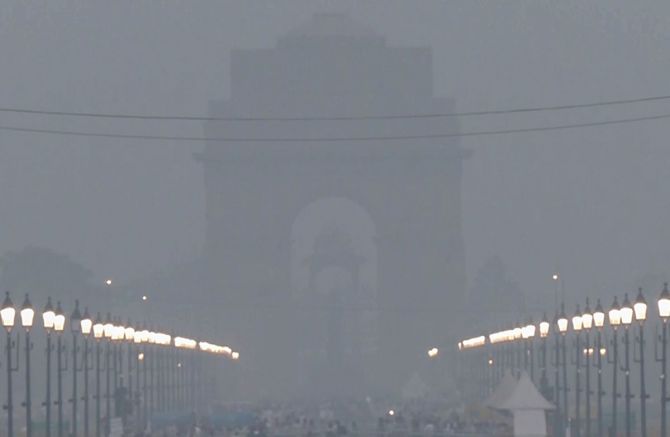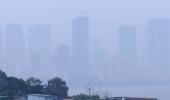Can artificial rain dissipate toxins in the air? As the skies over several parts of north India turn blue again and pollution levels improve from 'severe' but continue to be 'very poor', the question of whether cloud seeding can really be a long-term solution gathers urgency.

It is a tempting prospect and nothing more, say scientists, stressing on the need to tackle the problem at its root. Artificial rain is not just expensive - an estimated Rs 1 crore to induce rain in an approximate 100 square kilometre area - but also offers temporary respite.
“The respite artificial rain offers is short-lived... the return of polluted air swiftly restores hazardous levels, highlighting the need for more sustainable solutions,” Sunil Dahiya, an analyst with the Centre for Research on Energy and Clean Air, told PTI.
“Artificial rain can't be induced to last for days and over such large geography as NCR or north India which limits its usage as air pollution reduction technology for the region,” he added.
Cloud seeding involves dispersing particles of salt, such as silver iodide or chloride, onto clouds using aircraft. These salt particles serve as nuclei, promoting the formation of ice crystals within the clouds. Subsequently, the moisture present in the clouds adheres to these crystals, leading to rainfall.
The long-discussed issue came under the spotlight again when the Indian Institute of Technology-Kanpur announced its success with cloud seeding tests to combat persistent air pollution in the Delhi-NCR region, generating a mix of excitement and scepticism.
Sachchida Nand Tripathi, a distinguished expert in sustainable energy engineering at IIT Kanpur, explained that the technique involves injecting salts into clouds to induce rain formation.
“IIT Kanpur has in its possession an aircraft equipped with a cloud seeding device. The aircraft can fly up to 10,000 feet for about four hours. The institute has also developed its novel seeding solution of salts which has been tried for cloud seeding to initiate artificial rains,” Tripathi, the winner of the Infosys Prize 2023, for his research on large-scale sensor-based air quality network, told PTI.
"Data from India and other countries show an enhancement of about 20 per cent in rainfall in seeded clouds compared to non-seeded ones,” he said.
The sustainable impact of this process is under scrutiny, Tripathi added.
While the precise cost of cloud seeding experiments in India remains undisclosed, an estimated Rs 1 crore is believed to be required to induce rain in approximately a 100 sq km area. The tentative estimate came from an IIT Kanpur team headed by Manindra Agrawal, professor at the Computer Science and engineering department at the institute.
For several weeks in November and early December, the air quality index, which measures the concentration of PM 2.5 or fine particulate matter in the air, consistently surpassed the 400 mark in Delh-NCR. This was nearly ten times the acceptable limit.
According to the Air Quality Index report of Central Pollution Control Board the air quality in Delhi was in the ‘Very Poor' category on December 18, with an index value of 330.
Adding to the debate, Delhi Environment Minister Gopal Rai had disclosed that the government was contemplating the use of cloud seeding, a rain-making technique, to mitigate pollution levels.
According to environmental researcher Krishna AchutaRao, cloud seeding relies on specific atmospheric conditions to be effective.
“It is not just going up in an aircraft and sprinkling something. The required conditions are very hard to achieve in the months when air pollution is high - precisely because the conditions are not right for rain,” AchutaRao, head of the Centre for Atmospheric Sciences at IIT Delhi, told PTI.
“I heard one person claim that these conditions would arise during Western Disturbances. But such disturbances would themselves bring rain or even if they didn't, would bring winds and change the mixing in such a way that air pollution will decrease not just over Delhi but over a large area that the disturbance flows through,” he added.
Western Disturbances are cyclonic storms that form over land, and they originate mostly in the Mediterranean region.
AchutaRao noted that cloud seeding has been in practice for many decades.
“The first attempt to prove its efficacy in India was published recently by scientists from the Ministry of Earth Sciences and they found an increase of about 18 per cent due to seeding - that too in the month of July,” he added.
According to the Encyclopaedia Britannica, initial experiments with cloud seeding were conducted in 1946 by American chemist and meteorologist Vincent J. Schaefer. Since then, cloud seeding has been implemented using various methods, including aircraft, rockets, cannons, and ground generators.
While cloud seeding has found applications in air quality management and dust suppression in several countries, these endeavours have been sporadic at best.
China has invested significant sums to modify weather patterns, aiming to protect agricultural regions and enhance air quality, particularly in anticipation of large-scale events.
Similar efforts have been observed in other countries, such as Indonesia and Malaysia.
As the discourse on cloud seeding continues, experts stress the importance of addressing pollution at its source rather than relying solely on superficial solutions.
“In my opinion, these sorts of solutions are neither proven as a solution for washing out air pollution nor as effective compared to reducing emissions of pollutants and their precursors,” Dahiya said.
"In recent weeks, it has become evident that relying on sporadic rainfall is insufficient for achieving sustainable pollution control. The act of sprinkling water merely masks pollution temporarily without addressing its root cause,” he added.
The most efficient and cost-effective strategy for reducing air pollution lies in tackling emissions at their source, necessitating a concentrated effort in this direction, the scientists said.
“A comprehensive approach, including emission load caps and reduction targets, is crucial for meaningful change. Unfortunately, the National Clean Air Programme falls short by not establishing emission load caps and successive reduction targets for industries or regions contributing to pollution,” Dahiya said.
“Without adopting a comprehensive approach to emission load reduction at the airshed level, our reliance on superficial solutions such as water sprinkling, anti-smog guns, smog towers, or artificial rains will persist. Only by embracing a proactive and systematic approach can we truly and aggressively purify the air,” he added.
AchutaRao said investing in ineffective measures is a misallocation of resources, hindering genuine initiatives aimed at addressing emissions at their source.
Tripathi acknowledged the challenges, stating the geographical and temporal constraints of artificial rain become apparent, limiting its application as a broad-scale pollution reduction strategy.
“Seeding is one of the potential ways that can be tried in situ leading to rainfall that can reduce air pollution during severe pollution episodes by scavenging. Depending on cloud coverage and its nature seeding can initiate rain covering diverse regions,” he added.
Dahiya questioned the allocation of funds, emphasising the need to transition away from polluting technologies.
"Only by embracing a proactive and systematic approach can we truly and aggressively purify the air,” he added.










